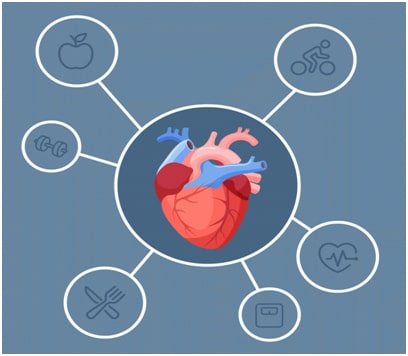Lipid Profile Test
Fats and fat-like substances are components of LIPIDS that are important constituents of cells and sources of energy of our body. A lipid profile measures the level of specific lipids in our blood.
As they are the form of fats they can cause obesity to severe cardiovascular disorder.
To prevent severe health issues, lipid profile can be done to assess the amount of particular form of lipid in a patient's body.
It is a simple blood test that serves as an initial screening test for abnormalities in lipids such as ‘bad ‘ or ‘good’ cholesterol and triglycerides.
Synonyms: Coronary Risk Panel, Lipid Profile, Fasting Lipid Panel, Non-fasting Lipid Panel, Cholesterol Panel, Lipid Test

Introduction
A little amount of cholesterol circulates in our body blood in form of complex substances called lipoproteins. Each of particles contains a combination of protein, cholesterol, triglyceride, and phospholipid molecules and the particles are classified by their density into high-density lipoproteins (HDL), low-density lipoproteins (LDL), and very low-density lipoproteins (VLDL). HDL-C particles, sometimes called "good" cholesterol, carry excess cholesterol away for disposal and LDL-C particles, or "bad" cholesterol, deposit cholesterol in tissues and organs. Monitoring and maintaining healthy levels of cholesterol is important for staying healthy. The body produces the cholesterol needed to work properly, but the source for some cholesterol is diet. In the event that an individual has inherited elevated cholesterol levels or eats a lot of the food stuff that are high in saturated fats and trans unsaturated fats (trans fats), at that point the degree of cholesterol in that individual's blood may increase and negatively affect the individual's wellbeing. The additional cholesterol in the blood might be kept in plaques on the walls of blood vessels. Plaques can narrow or in the long run obstruct the opening of blood vessels, prompting hardening of arteries (atherosclerosis) and it increases risk of various medical issues, including coronary heart diseases and stroke.
Why Get Tested?
The lipid profile test is expected to check for dyslipidemia side effects, it is additionally done to check grown-ups and youngsters who are chance inclined to high blood cholesterol worth and triglycerides. This happens in light of improvement of diabetes, hypertension or a coronary illness. This lipid profile test is likewise directed as a follow up to evaluate the treatment experienced and diet control program.
Your consultant may ask the patient to get a lipid profile done as a regular part of a health examination. Results from this test might be used to prevent, monitor, or diagnose various medical conditions. It may also be performed to evaluate the success of various treatments, or the effectiveness of drug therapies or lipid-lowering lifestyle changes.
The lipid profile test is expected to check for dyslipidemia side effects, it is additionally done to check grown-ups and youngsters who are chance inclined to high blood cholesterol worth and triglycerides. This happens in light of improvement of diabetes, hypertension or a coronary illness. This lipid profile test is likewise directed as a follow up to evaluate the treatment experienced and diet control program.
- Smoking And overweight
- Unhealthy diet
- Being physically inactive and not getting enough exercise
- If you are a male of 45 years or more or a female who is 50-55 years or more
- If you are suffering from hypertension
- Having a family history of premature heart diseases
- Pre-existing heart diseases
- If you’ve had a heart attack previously
- Having diabetes or pre-diabetes condition
A condition with high HDL level is considered as a "negative risk factor". Having significant levels of HDL take into consideration the removal of one risk factor. With kids and youths, it is prescribed to complete lipid profiles regularly.
Conditions Caused By Lipids
- Obesity
- Hypertension
- Heart Diseases
- Cardiovascular Diseases
- Stroke

What is being tested?
A lipid profile includes:
- Total cholesterol measures all the cholesterol in all the lipoprotein particles
- High-density lipoprotein cholesterol (hdl-c) measures the cholesterol in hdl particles; often called "good cholesterol" because hdl-c takes up excess cholesterol and carries it to the liver for removal.
- Low-density lipoprotein cholesterol (ldl-c) calculates or measures the cholesterol in ldl particles; often called "bad cholesterol" because it deposits excess cholesterol in walls of blood vessels, which can contribute to atherosclerosis. Usually, the amount of ldl-c is calculated using the results of total cholesterol, hdl-c, and triglycerides.
- Triglycerides measures all the triglycerides in all the lipoprotein particles; most is in the very low-density lipoproteins (vldl).
Some other information may be reported as part of the lipid panel. These parameters are calculated from the results of the tests listed above.
- Very low-density lipoprotein cholesterol (VLDL-C) calculated from triglycerides/5; this formula is based on the typical composition of VLDL particles.
- Non-HDL-C calculated from total cholesterol minus HDL-C
- Cholesterol/HDL ratio calculated ratio of total cholesterol to HDL-C
Need Of Test Preparation
Fasting for 9-12 hours (drinking water only, no food and beverages allowed) before having your blood drawn is required, but some healthcare practitioners allow non-fasting lipid testing. In particular, children, teens and young adults (ages 2 to 24) may have testing done without fasting. It is better to follow your instructor's advice.
Sample Required
A blood test is done by taking a sample by inserting a needle into a vein. In some cases a drop of blood is collected by puncturing the skin on a fingertip. This fingerstick test is ordinarily utilized when a chairside kit is utilized by a clinician.
When to Get Tested?
Screening when risk factors absent:
For adult-each 4 to 6 years;
For kids, youngsters and adult person,- one time between the ages of 9 and 11 and again between ages 17 and 21 years of age.
Monitoring: At regular intervals when you have risk factors, when prior results showed high risk levels, and/or to monitor effectiveness of treatment of diseases.
Normal Ranges Include
Risks Factors
Various risk factors are responsible for alterations in lipid profile and can cause serious illness later on. Factors include:
Sedentary lifestyle
Lack of physical exercise
Junk and fast food
Genetics
Certain diseases and medical conditions

Prevention From Risk
Regular exercise
Healthy diet
Fruits and vegetables
Regular health checkup
Statins
Popular Health Tests - Thyroid Profile Test - Full Body Checkup - Lipid Profile Test - Urine Routine Test - Blood Sugar Fasting Test - Kidney Function Test - Complete Blood Count Test - Liver Function Test - Diabetic Test



